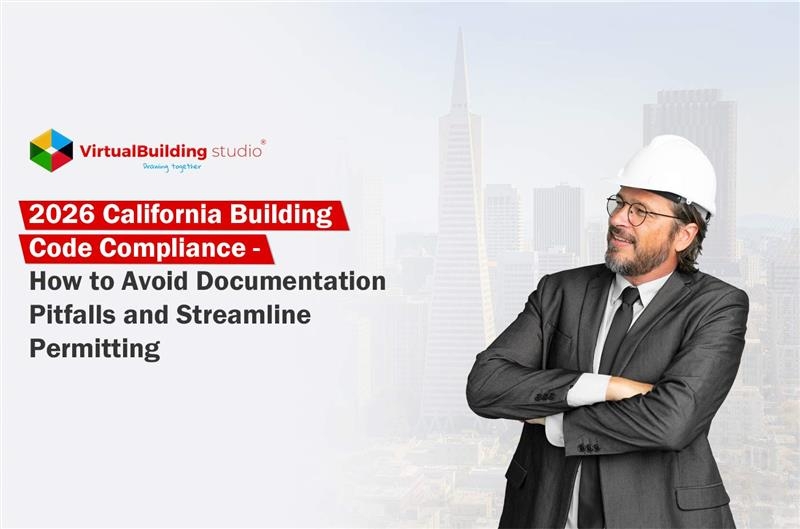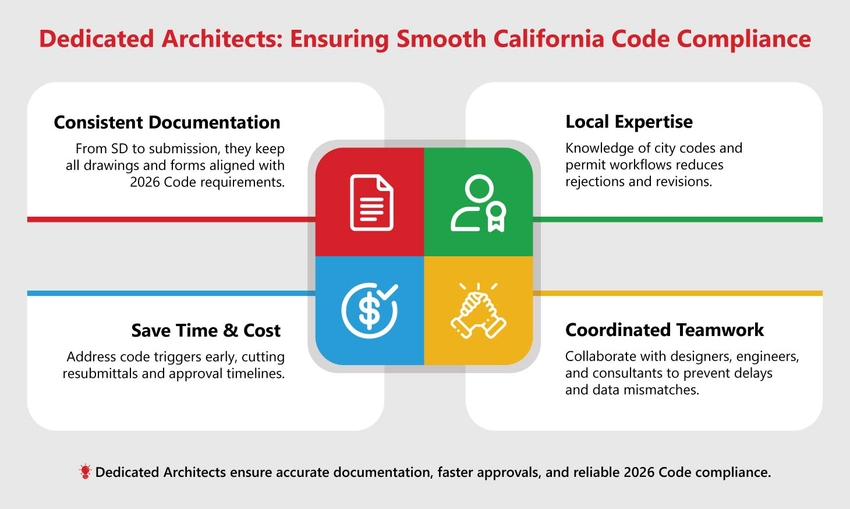
Navigating the New Era of California Building Standards Code
Prolonged review of plans. Unreliable timelines for permits. Repetitive corrections of documents. For many architecture firms, this is not the exception. This is the process, and with the 2026 California Building Code just around the corner, this process will become even more complicated.
The new 2026 CBC is not merely an update; the new code changes the way compliance is documented, verified, and approved. Newly foreseen rules on energy performance, electrification, seismic safety, and digital submittals mean design teams need to start thinking differently about documentation, a critical design deliverable that architects should begin to think of not as an afterthought.
This article is a strategic roadmap for architecture professionals to:
- Understand the key compliance challenges of the 2026 CBC.
- Recognize and sidestep documentation challenges that cause plan-check delays.
- Facilitate permitting with better processes and improved coordination.
In short, this article is your guide to engaging with the new California Building Code and complying with the regulations before the new code engages you.
Understanding 2026 California Building Regulations: Key Updates and Compliance Impacts
The 2026 California Building Standards Code Chapter (Title 24, 2025 Triennial Edition) represents one of the broadest changes in recent years for how architects will prepare, document, and submit designs for approval. Beyond design intent, diligence in documentation and digital coordination will shape compliance success.
Key Code Areas Affecting Documentation and Approvals
Energy Code (Title 24 Part 6): Stricter performance baselines will necessitate detailed energy modeling and verification of envelope, HVAC, and lighting systems.
Battery Energy Storage Systems (BESS): In addition, projects will now need to include documentation for BESS load management and coordination for safety with fire authorities.
Electrification Requirements: All-electric readiness for new construction and major remodels will also necessitate electrical load calculations and verification of service capacity.
Water Efficiency and Indoor Air Quality: Improvements in documentation will cover water reuse, fixture flow rates, and performance reports for ventilation.
Why Documentation Standards Are More Strict
Digital Submission: Most jurisdictions are moving toward ePlan systems with standardized templates and metadata tagging.
Energy Model Validation: Projects need to ensure alignment of design documents with energy model output with validated certified HERS Raters and Acceptance Test Technicians (ATTs).
Collaboration Across Disciplines: Structural, MEP, and architectural packages now need to reconcile data for automated checks on the plans.
Jurisdictional Submission Deadlines to Avoid 2026 California Building Code Compliance
| Jurisdiction | Critical Administrative Cut-off Date | Vesting Trigger | Notes & Key Considerations |
|---|---|---|---|
| Oakland | December 5, 2025 | Submission of completed Building Worksheet (BW) | A mandatory pre-review document is required for vesting. Final permit fee payment due December 31, 2025. Missing the BW deadline forces compliance with the 2026 Code. |
| Westminster | December 22, 2025 (11:59 PM) | Full and complete permit application | City-mandated early deadline due to holiday office closure. Late or incomplete submittals automatically fall under the 2026 Code. |
| Los Angeles (LADBS) | December 20, 2025 (Target) | Complete Plan Check submission + fee payment | Vesting rights are triggered only after fees are processed. Heightened risk due to LADBS reorganization and staffing transition in Q4 2025. |
| San Francisco (DBI) | December 31, 2025 (Final) | Complete permit application filed | No grace period. DBI historically enforces state deadlines with strict completeness reviews-submit mid-December to ensure processing. |
| San Jose | December 31, 2025 (Final) | Complete application filed | Use the Best Prepared Designer Program to secure early completeness determination and avoid year-end processing delays. |
| Sacramento County | December 31, 2025 (Final) | Complete application filed | Default adherence to the statewide effective date. Strongly advised to submit by December 20, 2025, to allow completeness review. |
| San Diego | December 31, 2025 (Final) | Complete application filed | Follows the state effective date. Local amendments may phase in later-monitor for reach-code updates. |
Note for Architects
While the 2022 Code will be effective statewide on January 1, 2026, most jurisdictions will not likely accept new applications under the 2022 Code until December 15, 2025, for completeness checks, staffing shortages, and holiday closures.
To protect your projects, consider December 15-20 as your internal deadline for submissions and make sure:
- Completed Title 24 (Part 6) energy documentation and CALGreen (Part 11) forms.
- Confirmed and paid plan check fees (with ZERO exceptions in LADBS).
- You either followed the administrative completeness checklist item by item for submittals, or you have documentation indicating the project conforms with any deviations from these documents.
Common Documentation and Coordination Challenges in 2026 California Building Code Submittals
The best designs may not even get approved if the documentation does not pass the admin review process. Under the new 2026 California Building Standards Code , agencies are tightening the completeness check process and automated accuracy tools, which means that coordination errors and inconsistencies may become more visible and costly.
Below are the mistakes you should not make:
Incomplete or Inconsistent Submittals
Missing energy forms (Title 24), expired CALGreen checklists, unverified load calculations, etc., are the primary contributing reasons for resubmittals. They are often partially incorrect documents. Even minor omissions will reset the plan review clock.
Design-Document Incongruence
Energy models or electrical load summaries don't match the architectural or MEP plans, and automated tools bring this to attention and freeze the review process.
Last Minute Revisions
A change to the EV infrastructure layout, HVAC equipment schedule, or layout of a solar/BESS surely requires fresh analysis under updated codes if not checked properly. Moreover, these late revisions can cause delays when new regulations apply to the modified designs.
Coordination Gaps Across Disciplines
When surveyors, architects, and engineers don't share the same data properly, they end up with different maps and utility layouts that don't match, creating problems with building codes and construction work.
Therefore, each area of gap adds to the administrative vulnerability, causing time delays, expensive re-designing, or value loss in vesting. Surveyors and design teams need to document and coordinate between arguments with a level of precision that is high enough to meet compliance, not merely a formal requirement.
How to Avoid Documentation Errors in the 2026 Building Code Regulations
The 2026 California Building Standards Code focuses on digital verification and stricter checks, so accuracy becomes the same important requirement from the very beginning, not just when submitting permits. We are seeing that managing documents early is only the key way to follow rules and avoid sending papers again, which can spoil project timing.
- Planning for compliance at an early stage helps organizations prepare better for regulatory requirements. This approach itself ensures that companies can address compliance issues further without facing major problems later.
- During schematic design itself, integrate Title 24 energy modeling with EV load calculations and further coordinate BESS systems. When we actually match building plans, site checks, and system sizes early, we definitely avoid problems between what we design and what we model.
- As per modern requirements, organizations should use cloud-based platforms for keeping all documents in one place and controlling their versions. This approach helps with better coordination and unified storage of important files. As per this system, survey data, topographic models, and consultant drawings stay updated together, reducing errors regarding old versions.
- Internal quality reviews help organizations check their work processes further and improve the system itself. Create multiple levels of quality checking lists and use the same process before submitting each work. Cross-check all geometry details, energy records, CALGreen forms, and utility drawings to surely remove any missing or wrong information. Moreover, this process will eliminate data that does not match properly.
- Training should actually happen regularly and definitely follow the same standards everywhere. As per the latest requirements, project teams must get training regarding new compliance forms, ATT/HERS protocols, and ePlan submittal standards. Regular training surely helps all documents follow proper formatting and completeness rules for each jurisdiction. Moreover, this practice ensures that every document meets the required standards without any gaps.
Basically, these strategies help surveyors and design teams make their documentation work the same as a precision-driven process, which reduces plan check delays and ensures timely code compliance.
How to Streamline the Permitting and Approval Process for 2026 CBC Compliance
The process of navigating the permitting process within the 2026 California Building Regulations is not merely about technical accuracy but also about improving communication with the local authority and real-time coordination across all disciplines.
Understand Jurisdictional Variances
Each Authority Having Jurisdiction (AHJ) is likely to interpret or adopt amendments to codes or other codes differently. Understanding documentation standards, completeness checklists, and digital submittal regulations of your local agency can all help prevent unnecessary review cycles.
Schedule Pre-Application Meetings
Plan reviewers can provide some insight into expectations to address code compliance and work through gaps in timing; this is useful in areas like energy modeling, EV infrastructure, or BESS documentation.
Utilize Digital Submissions
Employ an electronic plan review application for your agency, as these applications help facilitate the sharing and uploading of files electronically and mitigate changing workloads through mechanical rework. Files that have a constant digital version within your agency will reduce overall time in your review cycles by being consistent in digital presentation.
Track and Respond to Review Comments
Establish a process or a workflow for tracking plan comments from the agency and integrating comments into your process quickly. Being timely shows attention to detail and credibility with your reviewers.
This process, for architects, requires the ability to prepare to avoid surprises and better approvals and processes for results that maintain compliance and maintain schedules.

Planning for the Future: Compliance for 2026 and Beyond
When the 2026 California Building Code rolls out, you'll want to have a forward-thinking game plan in place and a seamless process for your project. Compliance is not simply a checkbox moving forward; it is the process of thoughtful design and resilient, future-focused developments.
Engaging with Dedicated Architects, surveyors, and AEC teams can rely on compliance experts to accurately document requirements, anticipate code triggers, and facilitate the approval process. Being proactive this way will mitigate costly resubmittals, enable ease for missing detail while coordinating, and strengthen a project; compliance becomes a strategic advantage instead of a logistical hurdle.
Consulting with well-qualified, US-trained Dedicated Architects will simplify your compliance experience and expedite project approvals.




